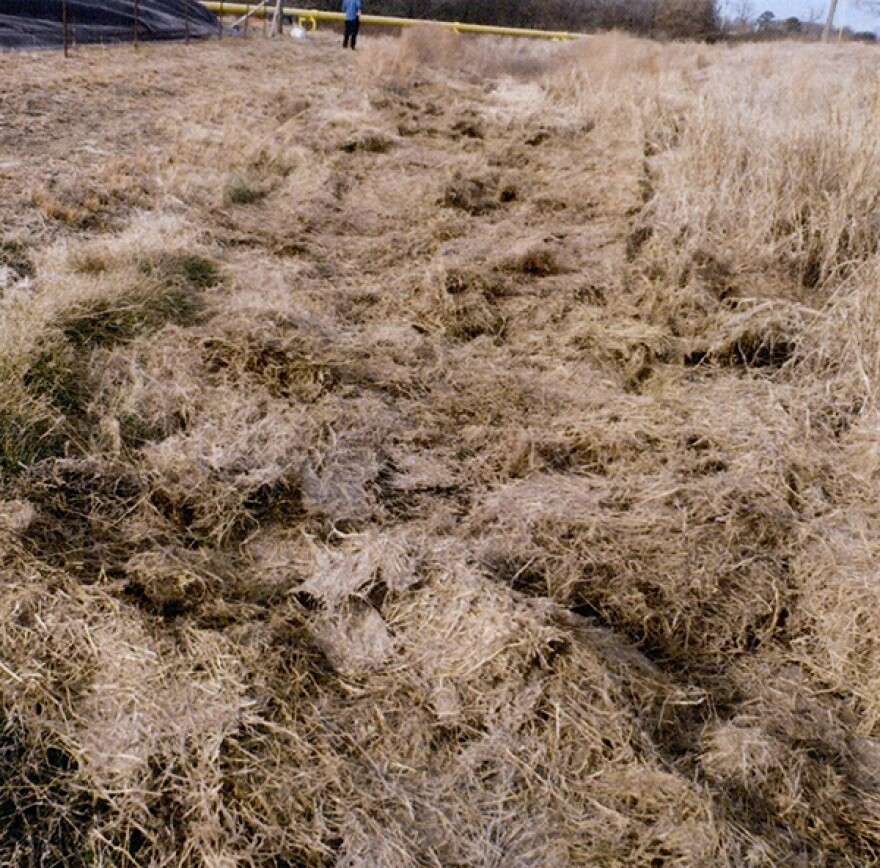An eastern North Carolina clean water organization is calling on the North Carolina Department of Environmental Quality to take further action after toxic foam escaped from a Wayne County biogas facility and polluted air, groundwater and surface water for weeks.
Sound Rivers’ Pamlico-Tar Riverkeeper Jillian Howell said the spill happened at White Oak Farms/Legacy Biogas in Fremont on Memorial Day weekend.
“The black cover that is over one of the lagoons that is there to capture the methane gas so it can by syphoned off and processed and made into electricity, that cover burst and the contents foamed out,” she explained, “This material was described as foam by the DEQ and the operators in the documents that we’ve gone through.”
What was in that foam? Howell said according to the facility’s permit, the slurry was comprised of a mix of things like, “Hog waste, there was dead hogs and there was, basically like expired food products brought to the site. So, things like deli meat and hotdogs.”

Most alarming to the organization, Howell said, is that the spill initially went unreported, even after the DEQ realized something was amiss at the farm during an inspection in February.
“DEQ’s inspector was out there and accidentally stepped into waste that had been spilled out of the digestor. The operators had covered the spill up in hay and so the inspector unknowingly stepped in it and sunk down and that’s how she found out that there was a spill that went unreported at this operation,” she said.

Howell’s colleague, Neuse River Keeper Samantha Kopp, flew over the facility during a routine monitoring of the watershed on August 3 and noticed significant earthwork was being done near the lagoon and digester -- and only then did the organization learn about the spill by looking through DEQ records.
“We only have estimates from the facility, and the facility itself estimated that more than three million gallons of this slurry of dead hogs, food waste products and swine waste came out of the digester and spread across the property,” Howell said.
She said the DEQ records show that the foam was observed on the surface waters of Nahunta Swamp, jurisdictional waters protected by the Clean Water Act. Howell said, “DEQ’s records, in their field inspection reports because they were out there in the weeks following this spill, they observed this material in the surface water of Nahunta Swamp. So, it’s unclear to us, and we’re still waiting on some records from DEQ but I think it’s also unclear to them, how much of this material made it into the waters.”

The only public notification about the spill, she said, came in the form of a small, bare bones public notice printed in two local newspapers by White Oak Farms/Legacy Biogas.
Howell said, “DEQ is the agency that is responsible for protecting the environment and people and they failed to notify anybody, so we’re requesting that they now issue some sort of public notice, press release detailing what happened, why it happened, how much was spilled and what the status of the cleanup process is right now.”
Sound Rivers is asking that the DEQ outline the extent of the groundwater contamination and monitor the water quality of Nahunta Swamp.
They’re also asking DEQ to revoke the permit to allow for the expansion of the CAFO – which began operating in the 1990s. “Up until 2013, they were permitted for 5,550 hogs on their property,” Howell said, “In 2013, they applied for and received a permit from DEW to expand their operation to 65,550 animals.”
Howell said that expansion was approved even though there was a moratorium in place in North Carolina on new CAFOs – confined animal feeding operations -- or the expansion of existing ones.
Currently, the pig farm is depopulated – there are no hogs living there -- and Howell said they are asking DEQ to ensure it remains that way.
Other asks – that DEQ revoke the permit that allowed for lunch meat, hot dogs and diced pig parts in the slurry and allow only hog waste in the digester; and that the agency modernized the methods used to notify the public when events like this occur, to reach more people than a small notice in the local newspaper.
“Public notification is incredibly outdated and has not kept pace with how people actually consume media and news,” Howell said, “I don’t have a subscription; I don’t get a paper delivered to my house every day.”
Sound Rivers is a financial supporter of Public Radio East.



